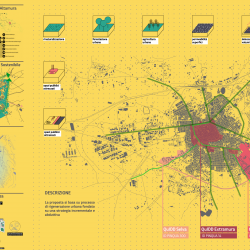
In Altamura, since the Second World War, a utilitarian approach to the territory and its resources has been affirmed, an intensive consumption of soil, indifferent to the problems of landscape protection and sustainability of transformations.
The fatigue and congestion of the consolidated city, unable to respond to expectations related to new economic models and quality of life, has determined, specularly, the transfer to the suburban areas.
The PINQUA strategy, called QuIDD (Innovative Neighborhoods Data Driven-Pinqua Extramura, Pinqua Selva and Pinqua Carpentino.), aims to recover a systemic vision of development initiated by the Administration in recent years with the integration of…
Claudia Trillo, University of Salford
Biodiversity is gaining increased popularity in the environmental planning debate and profession. The recently released Dasgupta Review strongly emphasised the importance of biodiversity for an healthy socio-economic growth, and recommended transformative and systemic change to tackle the global climate challenge. In the UK, Biodiversity Net Gain will soon become a mandatory requirement, thus calling for an approach to development and land management aimed at leaving the natural environment in a measurably better state than it was beforehand. How this could be reflected in the planning practice and projects? What practical examples can be shared…
Ennio Nonni, INU – URBIT
It is now necessary to broaden the horizon and discover the enormous potential and interactions for everything that falls under the wide concept of “green” as a path to sustainability.
The leitmotif of this meeting on horticultural therapy is to be in continuity with the four recent conferences promoted by INU-URBIT: “Urban green as a catalyst for urban regeneration”, “green in the city: how to face the challenges of climate change”, “The green that heals: the inner space and the city” and “Green therapy: healing with nature”.
Talking about vegetable gardens brings to mind the essential…
Markus Hedorfer, Alessandro Calzavara, ASSURB – National Association of Town, Spatial and Environmental Planners
Within the actions of governance, the interest in environmental issues (and more specifically to aspects related to sustainability and resilience of settlements and territorial transformations) has increased significantly in recent decades. It has grown enough to incorporate specific evaluation processes, such as SEA, Vinca (Natura 2000 sites assessment, NIS in Ireland or HRA in the UK), AIA (authorisations mainly referred to IPPC), etc., that strongly influence / guide the authorisation process.
In the proposed session, the aim is to compare the different possible approaches to this…
Ennio Nonni, Gianni Biagi, INU – URBIT
The green refers us to the forest, the park, the garden, the tree, in the three dimensions of protection, management and design.
It is a fact that the green at various scales is a driving force for the regeneration of the suburbs, for the fight against climate change, for the specific impact on public health and city livability.
If all this is consolidated, the new starting point should be to broaden the horizon and, through green, imagine cities, houses and a new world that is reconnected with nature in harmony with all living beings.
The green,…
